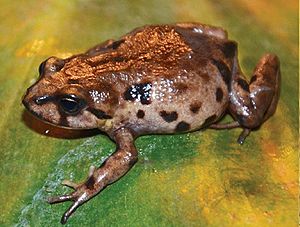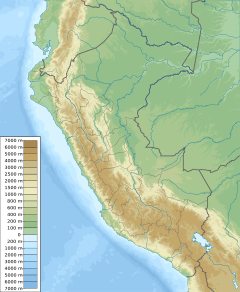Phrynopus juninensis facts for kids
Quick facts for kids Phrynopus juninensis |
|
|---|---|
 |
|
| Conservation status | |
| Scientific classification | |
| Phrynopus juninensis is only known from Cascas in Department of Junín, Peru | |
| Synonyms | |
|
The Phrynopus juninensis is a special type of frog. It belongs to the Strabomantidae family. This frog is found only in one place in the world: Peru. Scientists know it only from a small area called Cascas, near Huasihuasi, in the Department of Junín. Because it lives only in this one place, it is called an endemic species. People sometimes call this frog the Junin Andes frog.
Contents
What Does the Junin Andes Frog Look Like?
This frog is quite large for its group. Male Junin Andes frogs are about 2.2 to 3.1 centimeters (0.9 to 1.2 inches) long. Females are bigger, measuring about 3.3 to 4.1 centimeters (1.3 to 1.6 inches). This measurement is taken from their snout (nose) to their vent (tail end).
Body Features
The frog's snout is round when you look at it from the side. It does not have a visible eardrum (tympanum). Its toes also do not have any webbing between them.
Color and Markings
The back of the Junin Andes frog is dark brown. It has tan (light brown) spots. Its underside is silvery-white with tiny flecks. The frog's lips are a pale grayish-tan color with dark brown stripes. Its eyes are a shiny bronze color. You can also see dark brown stripes near its eyes. These stripes run from the snout to above where its eardrum would be.
Where Does the Junin Andes Frog Live?
The Junin Andes frog lives in special places high up in the mountains. It prefers primary montane cloud forests. These are old forests that are often covered in clouds. It also lives at the edges of these forests. These frogs live at very high elevations, about 3,508 to 3,525 meters (11,509 to 11,565 feet) above sea level.
Life Cycle and Habits
This frog is a terrestrial species. This means it lives mostly on the ground, not in water or trees. The Junin Andes frog has a unique way of growing up. Its development is direct. This means that baby frogs hatch directly from eggs. They do not go through a tadpole stage that lives in water.
Why Is This Frog in Danger?
The Junin Andes frog is very rare. It is known from only one small area. This makes it an uncommon species that is rarely seen by people.
Threats to Its Survival
Sadly, the Junin Andes frog is in danger. Its home is being lost because of farming. Farmers clear the forest to grow crops. This is called habitat loss. Another possible threat is the collection of Sphagnum mosses. These mosses are important for the forest environment where the frogs live.
Conservation Status
Because it is so rare and its habitat is disappearing, the Junin Andes frog is listed as Critically Endangered. This means it faces a very high risk of becoming extinct in the wild. Currently, this frog is not found in any protected areas. This makes it even more important to help save its home.



